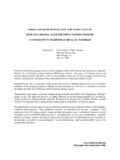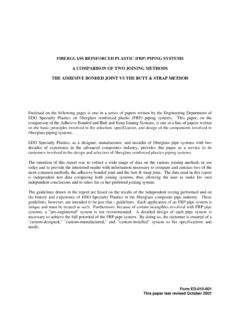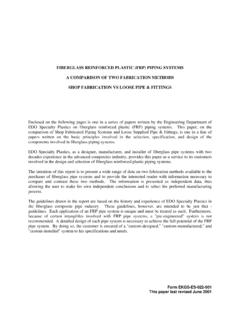Transcription of Fiberglass Reinforced Plastic (FRP) Piping Systems
1 Fiberglass Reinforced Plastic (FRP) Piping Systems . DESIGNING FOR VARIOUS LOADING CONDITIONS. A COMPARISON OF CURRENTLY AVAILABLE DESIGN PHILOSOPHIES. Prepared by: Kevin Schmit, Project Engineer EDO Specialty plastics Baton Rouge, LA. July 8, 1999. Enclosed on the following pages is one in a series of papers written by the Engineering Department of EDO. Specialty plastics on Fiberglass Reinforced Plastic (FRP) Piping Systems . This paper, on designing for various loading conditions, is one in a line of papers written on the basic principles involved in the selection, specification, and design of the components involved in Fiberglass Piping Systems .
2 EDO Specialty plastics , as a designer, manufacturer, and installer of Fiberglass pipe Systems with two decades experience in the advanced composites industry, provides this paper as a service to its customers involved in the design and selection of Fiberglass Reinforced Plastic Piping Systems . The intention of this paper is to present the various loading conditions encountered in above ground Piping system design. These loading conditions could be applicable to both metallic and non-metallic Piping materials.
3 This paper, however, will tend to concentrate on the considerations that must be made because of the unique properties of Fiberglass Reinforced plastics . The guidelines drawn in the report are based on the history and experience of EDO Specialty plastics in the Fiberglass composite Piping industry. These guidelines, however, are intended to be just that - guidelines. Each application of an FRP Piping system is unique and must be treated as such. Furthermore, because of certain intangibles involved with FRP Piping Systems , a "pre-engineered" system is not recommended.
4 A detailed design of each pipe system is necessary to achieve the full potential of the FRP. Piping system . By doing so, the customer is ensured of a "custom-designed," "custom-manufactured," and "custom-installed" system to his specifications and needs. Form EKGS-ES-043-001. This paper last revised August 1999. 1 Introduction: One of the obstacles that FRP ( Fiberglass Reinforced Plastic ) sometimes has to overcome is proper design of the materials for its intended application. While design specifications such as have existed for decades to provide guidance on the design of metallic materials, equivalent design specifications for non- metallics, such as FRP, have a much shorter history.
5 There are, however, more and more sources of design guidance for FRP and other non-metallics. This paper provides a comparison of some of the standards currently available to the FRP Piping designer. It provides, in detail, each standard's approach to calculating stresses due to various loading conditions. 2 An Introduction to the Codes and Standards ASME 1996. The history of the B31 codes dates back to its first publication in 1935 as the first edition of the American Tentative Standard Code for Pressure Piping .
6 From 1942 through 1955, the code was published as ASA. (American Standards Association) In 1955, the code was divided into separate documents for each industry section. ASA was first published in 1959. In 1978, the B31 committee was reorganized as the ASME Code for Pressure Piping B31 committee. There are various sections of the B31. code, which include: ASME Power Piping ASME Process Piping ASME Pipeline Transportation Systems for Liquid Hydrocarbons and Other Liquids ASME Refrigeration Piping ASME Gas Transportation and Distribution Piping Systems ASME Building Services Piping ASME Slurry Transportation Piping Systems The scope of the code, per , is to prescribe.
7 Requirements for materials and components, design, fabrication, assembly, erection, examination, inspection, and testing of Piping . Per , this code ..applies to Piping for all fluids, including: 1) raw, intermediate, and finished chemicals, 2) petroleum products, 3) gas, steam, air, and water, 4) fluidized solids, 5) refrigerants, and 6) cryogenic fluids.. For metallic Piping that is neither Category M nor high pressure fluid service, the code requirements can be found in Chapters I through VI. For nonmetallic Piping , the code requirements can found in Chapter VII.
8 The base code (Chapters I. through VI) only apply as stated in Chapter VII. 1 Rev: August 1999. ASME RTP-1 1995. The ASME RTP-1, Reinforced Thermoset Plastic Corrosion Resistant Equipment, was first published in 1989. Editions followed in 1992 and 1995. The purpose of this standard is to ..establish rules of safety governing the design, fabrication, and inspection during construction of such . The scope of RTP-1 1995, per 1-110a, includes ..stationary vessels used for the storage, accumulation, or processing of corrosive or other substances at pressures not exceeding 15 psig external and/or 15 psig internal above any hydrostatic head.
9 There are certain applications that are excluded from this standard, including 1) vessels with internal operating pressures exceeding 15psig, 2) hoods, ducts, stacks, 3) fans and blowers, 4) pumps, 5) Piping , and 6) fully buried vessels. ASME 1995 Boiler and Pressure Vessel Code Section X. The history of the ASME Boiler and Pressure Vessel Code dates back to 1911 with the establishment of a committee to formulate standard rules for the construction of steam boilers and other pressure vessels. The Boiler and Pressure Vessel Code is divided into different sections.
10 Section X is for Fiberglass Reinforced Plastic Pressure Vessels. Section X, per RG-100a, ..establishes the minimum requirements for the fabrication of fiber- Reinforced thermosetting Plastic pressure vessels for general service, sets limitations on the permissible service conditions, and defines the types of vessels to which these rules are not applicable.. Design pressures are limited based on the class type, as defined by Section X, and on the type of construction. Class I contact molded vessels are limited to 150psi; Class I filament wound vessels are limited to 1500psi; Class I filament wound vessels with polar boss openings are limited to 3000psi (Class I vessels are qualified through destructive testing; Class II vessels are qualified by design rules and non- destructive testing).












